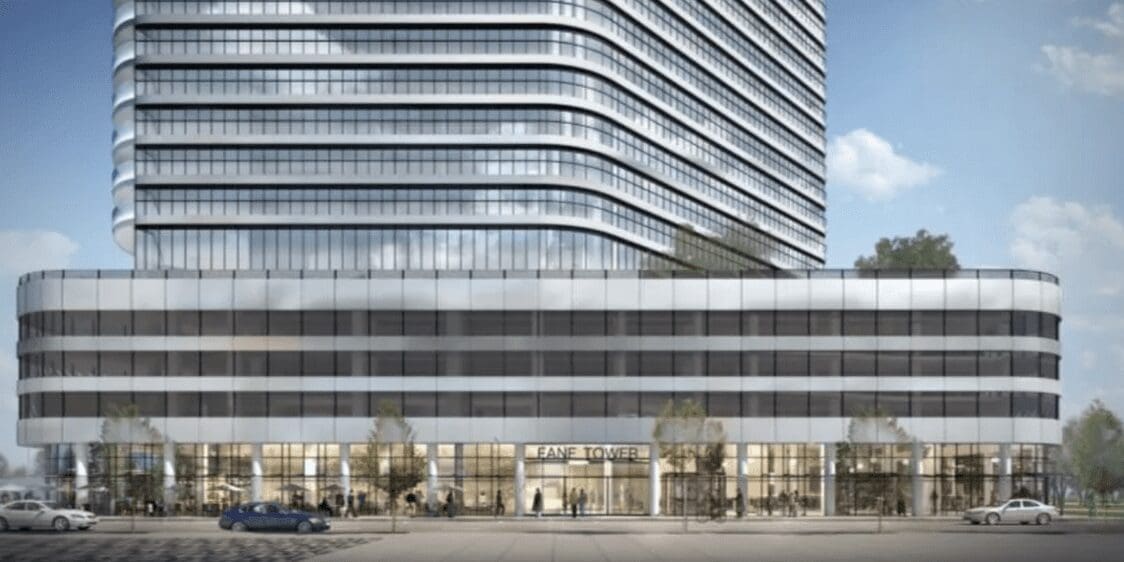Search Posts
Recent Posts
- Rhode Island Weather for June 15, 2025 – Jack Donnelly June 15, 2025
- To honor Pawtucket Mayor Henry Kinch: A tribute to leadership and legacy June 15, 2025
- Ask Chef Walter: Summer Feast for the Palate – Chef Walter Potenza June 15, 2025
- A Greener View: Floppy Perennials, Holey Vegetables and Wet Soil Gardening – Jeff Rugg June 15, 2025
- Gimme’ Shelter: Old Bay at the Providence Animal Control Center June 15, 2025
Categories
Subscribe!
Thanks for subscribing! Please check your email for further instructions.

Lessons from the Fane ouster – David Brussat
by David Brussat, Architecture Here and There, contributing writer
Lower portions of Hope Point Tower, which would have risen 600 feet in a 100-foot zone.
The so-called Hope Point Tower threat is gone, done in by inflationary costs and a dodgy market. Lessons from this interlude abound, chiefly that neighborhood opposition to poorly conceived proposals works. Jason Fane’s proposal for a 550-foot tower in a 100-foot height-restricted zone should not have been allowed in the first place. Obviously.
That it was allowed shows how ineffective and, frankly, clueless are the expert panels and their memberships, including, especially, the I-195 Redevelopment District Commission, all the way up through the Providence City Council and the Rhode Island Supreme Court, which, when charged with judging the legality of the proposal, issued a vapid, senseless jumble of meaningless words, laughingly considered the legal judgment of this high court. Providence mayor Jorge Elorza merits commendation for vetoing City Council’s approval of a change in zoning to jam the proposal into compliance with the Comprehensive Plan.
But where was Elorza before his veto? Where was he after it was issued? He should have put his foot down the moment the building was proposed. That was in 2016 – seven years ago.
Even before the pandemic there were many reasons to suspect that the target market for the Fane tower was suspect. Many projects serving an upmarket constituency here are more likely to find buyers and tenants than the Fane tower. In another location, such as the Financial District, its height might not have been so offensive, or even offended me so much, not even its design. (See “Put Fane tower downtown.”)
Fane’s team claimed that the proposal was a “tower in the park,” which to them meant that the applicable zoning restriction of 100 feet did not apply. This was highly debatable, but Jason Fane was probably well aware that nobody would object. He was wrong. Yes, local media was predictably on board – including a delusional supportive editorial (written after I left) by the Providence Journal – and drooling docility characterized the coverage of most of the rest of the media.
But even the local groups that arose in opposition, especially the Jewelry District Association, failed to grasp the most important reason to object to the Fane tower, which was its modernist style contrary to the city’s historical character. Perhaps local opposition should not be expected to be knowledgeable of how embracing historical character enables Providence to create valuable difference between itself and other cities, while rejecting our historical character inevitably does the reverse. Many find a mixture of contrasting styles to be an interesting look, but it nevertheless destroys historical character, undermining the city’s economy, its already minimal competitive advantages with other states in New England, and property values throughout the city.
The Providence Preservation Society has no excuse for its ignorance, but its stance is no surprise. It has been sympathetic to authoritarian-style modernism since not long after its creation in 1956. It does good work in many subsections of preservation, but on the big issues it has been on the wrong side, and it shows. This blog remains almost the sole opponent of PPS decision-making. Yes, it opposed the Fane tower – in surprising contrast to its record of support for many of the worst proposals in the city’s modern history – but in a Jan. 23 letter to the commission describing its opposition to the Fane tower, its rationale could have been applied equally well to many modernist buildings erected since the society’s founding in 1956. The society should have been the adult in the room, but that adult went missing, as it did for many buildings that mar the face of the city.
PPS even quoted the chief objection in law to the Fane tower: “The purpose of the D–1 District is to encourage and direct development in the downtown to ensure that new development is compatible with the existing historic building fabric and the historic character of downtown.” But PPS wasn’t listening.
Providence is marching in the same direction as most American cities – slower, perhaps, than others. But the destination is the same horror that many have already achieved.
___
To read other articles by David Brussat: https://rinewstoday.com/david-brussat-contributing-writer/

My freelance writing and editing on architecture and others addresses issues of design and culture locally and globally. I am a member of the board of the New England chapter of the Institute of Classical Architecture & Art, which bestowed an Arthur Ross Award on me in 2002. I work from Providence, R.I., where I live with my wife Victoria, my son Billy and our cat, Gato. If you would like to employ my writing and editing to improve your work, please email me at my consultancy, dbrussat@gmail.com, or call (401) 351-0451.
